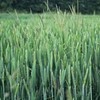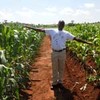New model developed to understand the variation in selenium concentrations in soil finds climate is key to its global distribution.
New model developed to understand the variation in selenium concentrations in soil finds climate is key to its global distribution.
There are many people suffering from “hidden hunger” across the world; people that have enough food to eat but have access only to food which does not contain adequate nutritional value. Micronutrients, or minerals, are an essential part of a healthy diet, gained from the soil via the crops we eat, yet many people don’t get enough of them. A new paper from Rothamsted Research has found that climate change could exacerbate this.
Deficiency in selenium, an important mineral, is thought to affect up to one billion people worldwide, contributing to problems such as poor immune function and heart muscle issues. The new research has found that selenium concentration in soils across the world is significantly affected by the climate and, if predicted changes in the climate do occur, levels will decrease in many areas.
In the UK, selenium concentrations are predicted to drop by more than 10 per cent in many parts of the country, a trend also seen across much of Europe and parts of South America, Asia and Africa. A slightly less steep drop of between 2.5-10 per cent is predicted to take place across much of North America and Asia.
In this research, soil selenium concentrations measured in 15 datasets from different parts of the world were laid on top of 26 variables describing soil, climate and vegetation properties in addition to land cover type, population density, geology, irrigation and soil erosion and other factors. Based on this model, the climatic factors were identified as the most important factor in soil selenium concentrations. Using this, the first ever global soil selenium concentration estimates were made for the years 1980-1999.
Given the importance of climate on soil selenium concentrations, predictions were then made for the years 2080-2099 to show how climate change could influence global soil selenium concentrations by the end of the 21st century. Fifty eight per cent of all modelled areas were predicted to experience a mean loss of selenium of 8.4 per cent. The effect is more pronounced in agricultural areas, where 66 per cent of modelled croplands were predicted to lose 8.7 per cent of current soil selenium levels, and 61 per cent of modelled pasture lands were predicted to lose eight per cent of current soil selenium levels.
Prof Steve McGrath, Head of Department of Sustainable Soils and Grassland Systems at Rothamsted Research, comments: “By developing a model that can track changes in the levels of minerals crucial to our nutrition, we are laying the groundwork for a solution to “hidden hunger”. This model has already revealed a very important fact; that climate can be a key factor in the distribution of some essential micronutrients across the globe.”
The research, which received strategic funding from the Biotechnology and Biological Sciences Research Council (BBSRC), ETH Zurich, the Swiss Federal Institute of Aquatic Science and Technology (Eawag), the University of Aberdeen and Potsdam Institute for Climate Impact Research was published today in the Proceedings of the National Academy of Sciences (PNAS).






